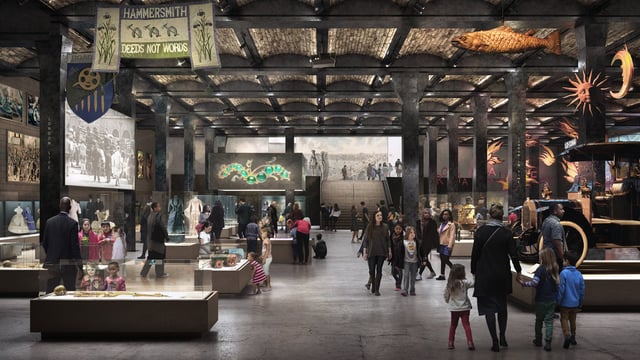At the end of 2022 the Museum of London at the Wall in the City of London closed its doors, having opened in 1976. A new museum is currently being created in the historic market buildings in the West Smithfield area of Central London. The new site is said to be easier to find and will have a lot more exhibition space to welcome many more visitors. This gives the curators a wonderful opportunity to rethink the telling of London’s stories. An integral part of the new museum will be the Great Fire of London, new research and teaching resources of which has just been made public to mark the 2023 anniversary of the 2 September 1666 event.
- Thomas Dowson
- Last Checked and/or Updated 1 September 2023
- No Comments
- London
The Museum of London was one of my favourite museums, telling the story of London from 450,000 BC to all aspects of the City’s contemporary past. Not only was the collection of artefacts extraordinary, but the displays made them a delight to see. In particular, I loved the prehistoric stone tools superimposed on a map of London where they were found. The small models of Roman London. The fact that architects added a viewing window on to the remains of the Roman and medieval wall of London, from within the Roman section. My favourite temporary exhibition was the display of the Cheapside Hoard, although there have been many other great ones.

Museum of London Becomes the London Museum
The Museum of London was established in 1976. Since then until December 2022 it was housed next to the London Wall in an iconic building that straddled a large traffic circle. The new location is not that far away, but it probably easier to get to and allows the museum to expand. To display more of its 7 million objects relating to London’s history. To take advantage of the change, there is a new name too, the London Museum.
Read more about the project, and follow the news on the New Museum for London website.

The Great Fire of London: New Research, New Resources, A New Display
To mark the 2023 anniversary of the Great Fire of London, which started on 2 September 1666, the Museum of London has announced new research which identifies the first witness of the Great Fire of London as Thomas Dagger, a journeyman baker in Thomas Farriner’s bakery on Pudding Lane.
The research undertaken for the new museum was carried out by Professor Kate Loveman, based at the University of Leicester. Loveman used information from letters, pamphlets, legal and guild records to conclusively find the identity of Thomas Dagger for the first time.

Thomas Farriner’s home was the first of 13,200 houses destroyed in the Great Fire, which began in his bakery.
Reports differ on who was in the bakery when the fire started. A letter from the MP Sir Edward Harley offers the most detailed account. He wrote that Thomas Farriner’s ‘man’ (meaning his servant or journeyman) was woken after 1am ‘with the choke of the smoke’. Farriner, his daughter and his man then escaped out of an upper window, but his maid died. Other sources make no mention of the unnamed man or maid, but refer to Farriner’s son being present.
The information gained from the records provides the surviving members of the Farriner household. They were Farriner, his adult children Hanna and Thomas, and his ‘man’, who can now be identified for the first time as Thomas Dagger. It was Dagger who reportedly “discovered” the Great Fire and raised the alarm (see, Who Discovered the Great Fire?).
The research will inform galleries at the London Museum. The museum’s popular Great Fire display will be reimagined, putting the stories of real Londoners at the forefront of a newly-designed, interactive space. The project, Reimagining the Restoration (funded by the Arts and Humanities Research Council), has developed exciting new teaching resources on the Great Fire. These resources are now available on the Museum of London’s website for teachers and children who want to explore life in the 1660s. The topic is especially pertinent to Key Stage 1 primary school learners, the majority of whom study the topic as part of the National Curriculum.
A key aspect of these new teaching resources is materials which show children, women, people of colour, and d/Deaf people at the time of the Great Fire of London (Deaf Londoners in the 1660s). The project aims to give teachers new ways to teach the Great Fire, give learners a sense of place and ownership over their history, and to spark interest in the 17th century.
Kate Loveman, Professor of Early Modern Literature and Culture at the University of Leicester, said: “It was fascinating to find out more about what happened on that famous night. Although most of the evidence about the Farriners is well known to historians, Thomas Dagger’s role has gone unrecognised. Unlike the Farriners, his name didn’t become associated with the fire at the time. Soon after the disaster, he merges back into the usual records of Restoration life, having children and setting up his own bakery. His is a story about the fire, but also about how Londoners recovered.”
Meriel Jeater, Lead Curator for the Museum of London’s new Great Fire displays, said: “This discovery will feed into the exciting new ways in which we’ll be telling the story of the Great Fire of London in the London Museum. “The museum holds a broad range of items relating to the Great Fire and our aim is to combine these with new research to create an immersive experience which foregrounds historical Londoners using their stories and their own words via letters and diary entries. “Our aim is to make the London Museum the best city museum in the world, welcoming millions more visitors than our previous site at London Wall. The Great Fire display will be an integral part of this and our new approach will help us engage more schoolchildren than ever before, as well as ensure that we’re telling the story of the fire in the most accurate and engaging way possible.”
Laura Thomson-Turnage, Senior Learning Manager at the Museum of London, said: “We were delighted to work with the University of Leicester on this project and Professor Loveman’s research has enabled us to make our learning resources around the Great Fire of London even more relevant to London’s diverse school population. The varied resources we’ve developed include films to be used in the classroom, a comic book resource about d/Deaf Londoners in the 1660s and information packs to support all types of teachers whether they are newly-qualified or very experienced.”
Looking for information about the Great Fire of London? The museum’s website has a detailed set of pages about the fire, from historic articles and objects, to games and an immersive Minecraft experience. From how it started, to how it was stopped, an how it changed the City of London. Read all you need to know about the Great Fire on the museum’s website.

Add the London Museum to Your Itineraries & Travel Lists
If you are already planning your itinerary for 2026, book mark this page for updates and news about the opening dates. In the meantime you can create your own travel lists (such as places you have been to, places you would like to visit) and an itinerary for your London visit. These can also be shared with your friends and on social media. You can see how this is done by watching our Using the Itinerary video on YouTube, or reading the Using the Itinerary page.
For more sites and museums in Greater London, see Art, Archaeology & History Sites & Museums in London.
The London Museum - Opening 2026
The Museum of London at the Wall closed its doors to the public in December 2022. It opened to the public in 1976. The museum will open again in 2026, in a new location and with a new name: the London Museum in West Smithfield, not far from the Wall site. The new location allows for a greater part of the museum’s 7 million+ objects to be displayed. The museum will continue to cover all aspects of London’s story, from 450,000 BC to the present.






